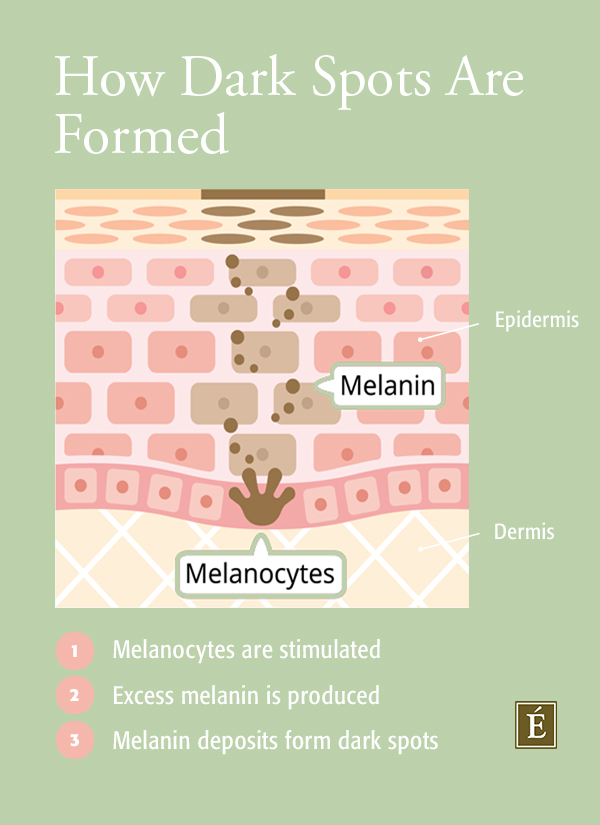
Are you a mom-to-be? With pregnancy comes plenty of change, and that includes the look and feel of your skin. If the “pregnancy glow” you were promised is overshadowed by pigmentation, you’re not alone. As many as 70% of women experience darkening around the upper lip, cheeks and forehead during pregnancy. Read on to learn more about melasma and what you can do to minimize its appearance.
What Is Melasma?
The patches of discoloration that appear during pregnancy are known as melasma or "mask of pregnancy." Most commonly, dark patches will appear on the cheeks, upper lip or forehead. In some women, these splashes of pigment will be light and barely visible; in others, they will be darker and more prominent. For most, melasma will emerge early on in pregnancy and fade after delivery.

Signs
Common signs of melasma are brown or gray-colored splotches that are darker than your usual skin color. Unlike dark spots, patches of melasma tend to be large and symmetrical (you’ll experience similar splashes of color on either side of your face). This type of discoloration typically appears in these areas:
- Cheeks
- Forehead
- Bridge of the nose
- Upper lip
- Chin
What Causes It?
Melasma (also known as chloasma) is a direct result of hormonal changes during pregnancy. When pregnancy hormones spike, they stimulate melanogenesis — the production of melanin. Melanin is the substance that gives our hair, eyes and skin their color. As its production increases, existing dark spots and moles become more pronounced and new spots and patches emerge.

Melasma is most common in women. According to the American Academy of Dermatology, 90% of people who develop melasma are female. It tends to run in families, and darker skin types are more prone to developing symptoms due to having more naturally active melanocytes. Since it is triggered by hormonal fluctuations, melasma can also occur when you start or stop using hormonal contraception or undergo hormone replacement therapy.
How To Minimize Melasma
Folic Acid
Eat foods high in folate (vitamin B9). A deficiency in folic acid, which is common in women who are pregnant or on birth control, has been linked to the development of melasma. Add citrus fruits, legumes, leafy greens and whole grain breads and cereals to your diet. You can also talk to your physician about taking a folic acid supplement.
Avoid Sun Exposure
Sun exposure can worsen melasma. Limit time spent in the sun and take necessary precautions, including covering exposed areas and applying an SPF with UVA and UVB protection. Instead of a chemical sunscreen, choose a mineral sunscreen that blocks, rather than absorbs, light and heat. Dermatologist Alison Sutton tells Today’s Parent: "Less light exposure will hopefully lead to less melasma, fewer flare-ups and lighter hyper-pigmentation."
Topical Skin Care
Many dermatologists will prescribe bleaching agents, such as hydroquinone, to lighten the dark spots caused by melasma. This chemical compound inhibits the function of tyrosinase, the enzyme that signals the production of melanin in the skin’s melanocytes. By doing so, it reduces melanin production and fades hyperpigmentation. However, the safety and side effects of hydroquinone remain questionable; the chemical has been linked to several skin irritations as well as cases of over-lightening, resulting in white “halo” spots. For a safer option, swap out hydroquinone for natural alternatives.
Skin Care For Melasma
Melasma is stubborn, but targeted skin care products can minimize its appearance.
Eight Greens Collection
Skin that suffers from melasma often reacts well to phytoestrogens in skin care. These plant-based compounds have a chemical structure similar to estrogen, enabling them to interact with estrogen receptors in cells. But, not all phytoestrogens work the same: Some block estrogen’s effects, while others amplify it. In treating melasma, phytoestrogens act as tyrosinase inhibitors and suppress melanin production, thereby minimizing the look of dark spots and pigmentation.
In addition to adding phytoestrogens to your diet, you can apply them topically through your skin care. Our Eight Greens Collection, which includes the Eight Greens Phyto Masque and Eight Greens Youth Serum, contains extracts of yucca, flaxseed, hops and red clover to help with a more even-looking complexion.
Bright Skin Collection
You can also minimize melasma with natural skin brighteners. Our Bright Skin Collection is a full routine that includes a blend of natural ingredients that provide similar results to hydroquinone without the potentially negative effects. Here’s how each one diminishes the look of dark spots:
- Bearberry Extract: Contains a natural form of hydroquinone and arbutin as melanin-inhibitors
- Licorice Root: Contains liquiritin and glabridin which disrupt melanin creation
- Tara Tree & African Potato: Reduce tyrosinase activity and hinder its development
- Swiss Alpine Plant Extracts: Contains seven organically grown Swiss alpine plants that inhibit tyrosinase
Natalie’s favorites from this collection include the Bright Skin Overnight Correcting Cream and Bright Skin Targeted Treatment.
Do you struggle with melasma? We’d love to hear your story. Share it with us in the comments below and join the conversation on social media.



